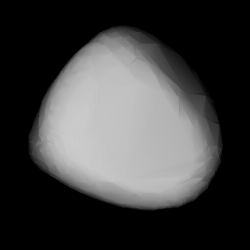Astronomy:214 Aschera
From HandWiki
Short description: Main-belt asteroid
 3D convex shape model of 214 Aschera | |
| Discovery | |
|---|---|
| Discovered by | Johann Palisa |
| Discovery date | 29 February 1880 |
| Designations | |
| (214) Aschera | |
| Pronunciation | /əˈʃɪərə/[1] |
| A880 DB, 1903 SE 1947 BP, 1948 JE 1949 QG2, 1949 SX1 1950 XH, 1953 OO | |
| Minor planet category | Main belt |
| Orbital characteristics[2] | |
| Epoch 31 July 2016 (JD 2457600.5) | |
| Uncertainty parameter 0 | |
| Observation arc | 136.09 yr (49707 d) |
| |{{{apsis}}}|helion}} | 2.6938 astronomical unit|AU (402.99 Gm) |
| |{{{apsis}}}|helion}} | 2.5279 AU (378.17 Gm) |
| 2.6108 AU (390.57 Gm) | |
| Eccentricity | 0.031762 |
| Orbital period | 4.22 yr (1540.9 d) |
| Average Orbital speed | 18.43 km/s |
| Mean anomaly | 167.065° |
| Mean motion | 0° 14m 1.068s / day |
| Inclination | 3.4364° |
| Longitude of ascending node | 341.997° |
| 131.579° | |
| Physical characteristics | |
| Dimensions | 23.16±1.0 km |
| Rotation period | 6.835 h (0.2848 d) |
| Geometric albedo | 0.5220±0.048 |
| E | |
| Absolute magnitude (H) | 9.2 |
Aschera (minor planet designation: 214 Aschera) is a Main belt asteroid. It was discovered by Austrian astronomer Johann Palisa on February 29, 1880, in Pola and was named after the Sidonian goddess Asherah.
It is classified as a rare E-type asteroid and is fairly faint for an object of its type. The overall diameter is estimated to be 23 km and it has a geometric albedo of 0.52.[3] Photometric observations show a rotation period of 6.835 ± 0.001 hours with a brightness variation of 0.20 in magnitude. Using a tri-axial ellipsoidal model derived from light curve data, the overall shape of the asteroid is estimated to be a/b = 1.24 ± 0.12 and b/c = 1.83 ± 0.10, where a, b, c are the three axes of an ellipsoid.[4]
References
- ↑ "Asherah". Merriam-Webster Dictionary. https://www.merriam-webster.com/dictionary/Asherah.
- ↑ "214 Aschera". JPL Small-Body Database. NASA/Jet Propulsion Laboratory. https://ssd.jpl.nasa.gov/sbdb.cgi?sstr=214;cad=1.
- ↑ Mishchenko, Michael I.; Rosenbush, Vera K. (2011), "Opposition Optical Phenomenon in Planetary Astrophysics: Observational Results", Polarimetric Detection, Characterization and Remote Sensing (Springer Science & Business Media): p. 417, ISBN 978-9400716353, https://books.google.com/books?id=tdPBENFJTe0C&pg=PA417.
- ↑ Shevchenko, V. G. et al. (August 2003), "Rotation and photometric properties of E-type asteroids", Planetary and Space Science 51 (9–10): 525–532, doi:10.1016/S0032-0633(03)00076-X, Bibcode: 2003P&SS...51..525S.
External links
- The Asteroid Orbital Elements Database
- Minor Planet Discovery Circumstances
- Asteroid Lightcurve Data File
- 214 Aschera at AstDyS-2, Asteroids—Dynamic Site
- 214 Aschera at the JPL Small-Body Database
 |

